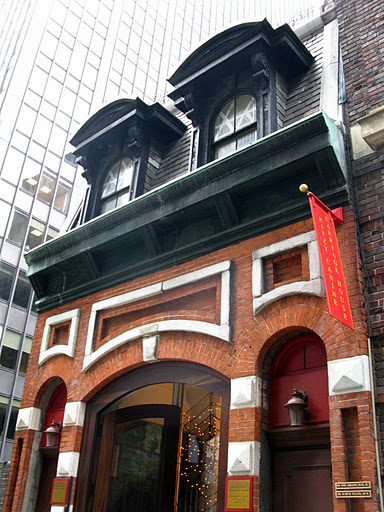 |
| photo by Alice Lum |
Allen’s plans for his private stable changed, however, and on February 22 he purchased the lot next door at No. 428. At the time utilitarian structures like carriage houses were as much a reflection of one’s social position and wealth as was his home. While most New Yorkers affluent enough to afford their own horse and carriage used the services of boarding stables; the wealthy erected handsome private stables on side streets for their convenience.
Jonathon W. Allen was a successful broker with a fashionable home at No. 18 East 42nd Street, just off Fifth Avenue. The 40th Street plot was near enough to prevent the Allens from waiting overly long after summoning their carriage. When ground was broken for the new stable, three others were already standing along East 40th.
As the Real Estate Record reported, Allen contracted builder Charles E. Hadden, whom the Trow City Directory listed as being in business with his brother, Beverly W. Hadden, to design and construct the carriage house. The result would be less ambitious than the 4-story structure of the Record’s report; but it would be no less impressive.
 |
| Limestone outlines the decorative recessed areas of the facade and thick slate shingles cover the mansard roof -- photo by Alice Lum |
Above the ground floor service area where carriages, horses and fodder were kept were living accommodations for at least one groom or stable boy. Taking its cue from the grand French Second Empire houses and commercial buildings rising around the city at the time, Allen’s two-story stable managed to be striking and delightful at the same time.
 |
| photo by Alice Lum |
Then, in 1928 the building was threatened when the New York Con Edison Company purchased the property as part of a planned an extension of the 39th Street electrical distribution station. The power plant would require the demolition of the stable and the structure next door. The Murray Hill Association filed suit in the Supreme Court to halt the plans.
The Association complained that the existing plant on 39th Street had already “caused trouble for adjoining buildings” due to vibrations. The New York Times commented that “They contend that if the Court permits the construction of this building it will initiate an invasion by business of a residence district.”
The Court apparently agreed because the little brick building which was still being used at a stable was spared.
Stuck with the property, the utility company leased it. In October of 1937 sculptor John E. Flannigan rented the building, altering the ground floor carriage space into a studio with an apartment upstairs.
 |
| The blend of materials and attention to detail reflected Allen's social station -- photo by Alice Lum |
Today Jonathan Allen’s private stable is home to a luxury dog-and-cat day care facility. The last vestige of the 19th century on the block, it was described by the AIA Guide to New York City as “A distinguished mansard-roofed emissary in miniature from France’s Second Empire, languishing amid characterless high-rises on all sides.”
